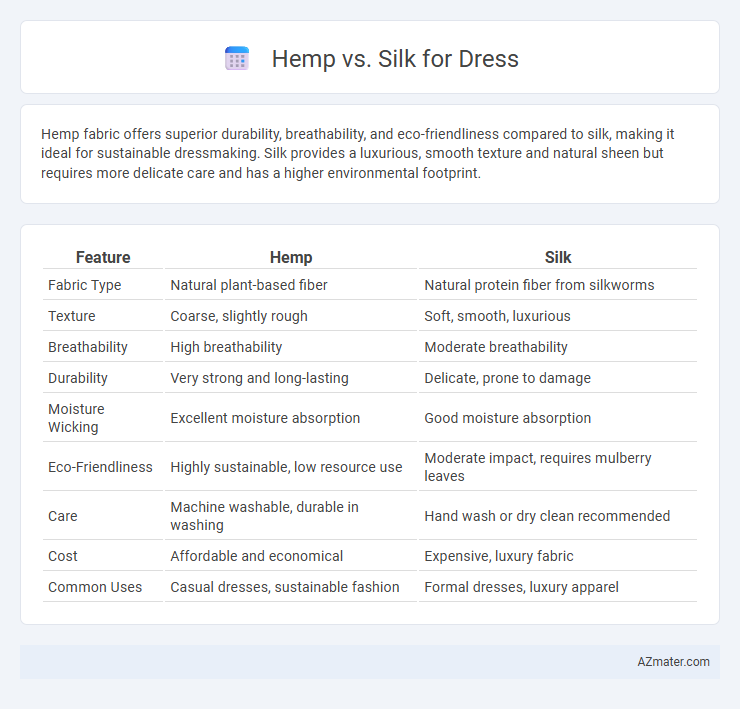Hemp fabric offers superior durability, breathability, and eco-friendliness compared to silk, making it ideal for sustainable dressmaking. Silk provides a luxurious, smooth texture and natural sheen but requires more delicate care and has a higher environmental footprint.
Table of Comparison
| Feature | Hemp | Silk |
|---|---|---|
| Fabric Type | Natural plant-based fiber | Natural protein fiber from silkworms |
| Texture | Coarse, slightly rough | Soft, smooth, luxurious |
| Breathability | High breathability | Moderate breathability |
| Durability | Very strong and long-lasting | Delicate, prone to damage |
| Moisture Wicking | Excellent moisture absorption | Good moisture absorption |
| Eco-Friendliness | Highly sustainable, low resource use | Moderate impact, requires mulberry leaves |
| Care | Machine washable, durable in washing | Hand wash or dry clean recommended |
| Cost | Affordable and economical | Expensive, luxury fabric |
| Common Uses | Casual dresses, sustainable fashion | Formal dresses, luxury apparel |
Introduction to Hemp and Silk Fabrics
Hemp fabric is derived from the fibers of the Cannabis sativa plant, renowned for its durability, breathability, and eco-friendly cultivation with minimal pesticide use. Silk fabric, produced from the cocoons of silkworms, is prized for its luxurious softness, natural sheen, and excellent drape, making it a staple in high-end fashion. Both materials offer distinct advantages: hemp emphasizes sustainability and strength, while silk provides elegance and smooth texture in dressmaking.
Origins and Production Processes
Hemp fabric originates from the stalks of the Cannabis sativa plant, known for its rapid growth and minimal need for pesticides, making it a sustainable choice in textile production. Silk is produced through the labor-intensive process of harvesting cocoons from Bombyx mori silkworms, involving boiling the cocoons to extract fine natural protein fibers. Hemp production emphasizes eco-friendly, low-impact farming, while silk production relies on delicate sericulture techniques and traditional craftsmanship.
Environmental Impact Comparison
Hemp fabric requires significantly less water and pesticides compared to silk production, making it a more sustainable option for dress materials. Hemp cultivation also sequesters more carbon dioxide and improves soil health, reducing overall environmental footprint. Conversely, silk production involves intensive mulberry farming and energy-consuming silkworm processing, contributing to higher resource consumption and ecological strain.
Texture and Comfort: Hemp vs. Silk
Hemp fabric offers a coarse, sturdy texture that softens with wear and provides excellent breathability, making it ideal for comfortable, durable dresses. Silk features a smooth, luxurious texture with a natural sheen, delivering unparalleled softness and a lightweight feel that drapes elegantly on the body. While hemp excels in moisture-wicking and durability, silk stands out for its gentle touch and temperature-regulating properties, enhancing overall comfort.
Durability and Longevity
Hemp fabric showcases exceptional durability with its strong natural fibers that resist wear and tear, making it ideal for long-lasting dress materials. Silk, while luxurious and smooth, tends to be more delicate and prone to damage from friction and sunlight exposure, reducing its longevity in everyday wear. Choosing hemp over silk for dresses ensures greater resistance to stretching, tearing, and fading, providing a sustainable option that maintains its structural integrity over time.
Breathability and Climate Suitability
Hemp fabric offers superior breathability compared to silk, making it ideal for hot and humid climates due to its moisture-wicking and quick-drying properties. Silk, while luxurious and smooth, traps heat more than hemp and is better suited for moderate to cooler environments. Choosing hemp for dresses promotes natural ventilation and comfort, especially in warm weather, whereas silk provides elegance with temperature regulation in less humid conditions.
Color, Dyeability, and Aesthetic Appeal
Hemp fabric offers excellent dye absorption, resulting in vibrant and long-lasting colors that resist fading, while silk is prized for its natural luster and ability to reflect light, producing rich, deep hues. Silk's smooth texture complements its color vibrancy, giving dresses an elegant, luxurious aesthetic, whereas hemp's slightly coarse texture provides a more rustic, earthy appeal with a matte finish. Both materials support diverse dye techniques, but hemp's eco-friendly cultivation and durability make it a superior choice for sustainable, colorful fashion statements.
Maintenance and Care Requirements
Hemp dresses require minimal maintenance, often needing only gentle washing with mild detergent and air drying to preserve fabric integrity and prevent shrinkage. Silk dresses demand more delicate care, including hand washing or dry cleaning, avoiding harsh detergents, and keeping them away from direct sunlight to maintain the fabric's natural sheen and prevent damage. Proper storage for both materials involves cool, dry environments, but silk benefits from padded hangers to avoid creasing, while hemp's durability allows for more flexible options.
Price and Affordability
Hemp fabric is significantly more affordable than silk, making it a cost-effective choice for dresses without compromising durability. Silk, being a luxury natural fiber, commands a higher price due to its labor-intensive production and premium texture. Consumers seeking budget-friendly and sustainable dress materials often prefer hemp for its competitive pricing and eco-friendly appeal.
Choosing the Right Fabric for Your Dress
Hemp fabric offers exceptional durability, breathability, and eco-friendly benefits, making it an ideal choice for sustainable dress options, especially in warm climates. Silk provides a luxurious, smooth texture and natural sheen, perfect for elegant, formal dresses requiring a lightweight and soft feel. Consider your dress's purpose, desired comfort, and environmental impact to select between hemp's robustness and silk's refined aesthetics.

Infographic: Hemp vs Silk for Dress
 azmater.com
azmater.com